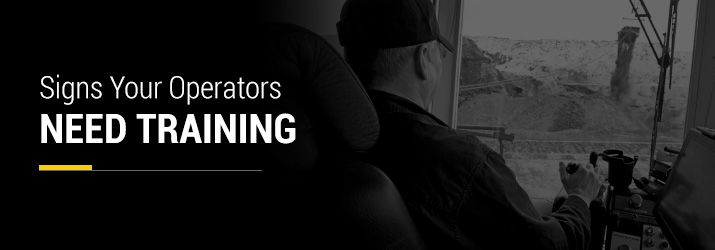
Your entire business is in the hands of your equipment operators. Do you trust them? Sometimes it can be tough to know if the training you have in place is good enough. If it’s not, there could be big implications when it comes to legal and financial risks for your business. It’s tempting to take on the mindset of “if it isn’t broke, don’t fix it.” However, you may be missing signs that your equipment operators need training. Rather than waiting until these signs turn into an expensive disaster, learn the signs and look for them now so you can develop a plan to improve.
Jump to Sections:
- Signs That Equipment Operators Need Training
- How to Begin a Heavy Equipment Operator Training Program
- Risks Associated with Not Training Operators
- Benefits of Operator Training
Signs That Equipment Operators Need Training

When you hire a new equipment operator, do you have a formal operator training process in place, or do you send them out into the field with a seasoned employee to learn the ropes? How do you handle new equipment training? While a formal equipment training process is ideal, you aren’t alone if you don’t have one in place. The problem is that a lack of operator training exposes you to a whole new set of risks — not only for employee safety, but also for equipment expenses. How can you tell if the training you have in place is making the cut?
Here are a few signs your equipment operators need more training:
1. Your company fails to meet goals and deadlines.
If you’ve been scratching your head wondering why you’re failing to meet production goals and deadlines, you aren’t alone. It can be hard to pinpoint a cause when there are so many factors that can interrupt your work schedule — weather, suppliers, materials and untrained operators. If you’re missing goals and deadlines frequently, there’s a good chance unskilled operators are a significant part of the problem.
When equipment operators are trained and know how to get the most out of their equipment, they get work done quicker without sacrificing quality. If you have employees operating equipment they haven’t formally been trained on, chances are they aren’t maximizing the use of the equipment — meaning it isn’t being run as efficiently and effectively as it could be. You may not be able to control the weather, suppliers and materials, but you do have the ability to ensure your operators are adequately trained.
2. You’re replacing equipment parts sooner than expected.
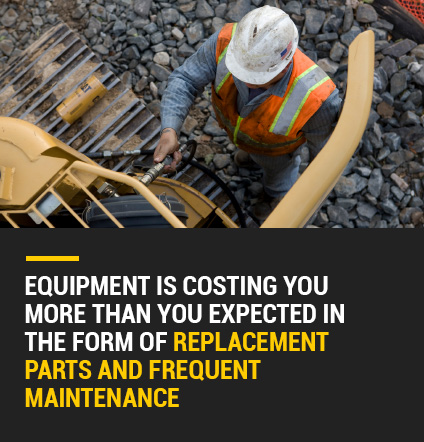 If your employees aren’t using the equipment as efficiently and effectively as they could be, it will likely lead to our second sign: equipment is costing you more than you expected in the form of replacement parts and frequent maintenance. While a job site environment can have an impact, equipment that isn’t run properly often shows signs of wear and tear sooner as a result of the improper use. For example, tires and undercarriages are two expensive items that inappropriate use can significantly impact.
If your employees aren’t using the equipment as efficiently and effectively as they could be, it will likely lead to our second sign: equipment is costing you more than you expected in the form of replacement parts and frequent maintenance. While a job site environment can have an impact, equipment that isn’t run properly often shows signs of wear and tear sooner as a result of the improper use. For example, tires and undercarriages are two expensive items that inappropriate use can significantly impact.
In addition to the physical condition of the equipment, untrained operators could be costing you money when it comes to two other important equipment maintenance factors — inspections and machine alerts. Equipment operators should be inspecting the equipment every day. If they haven’t been trained on that particular piece of equipment, how do they know what to inspect?
The same goes for alerts — as technology on equipment continues to advance, alerts are put into place to alert the operator when something isn’t working the way it should. Can you rely on an untrained operator to respond to and/or report those alerts? If something isn’t working right, it’s important to catch it before it turns into a more significant issue. Untrained operators may not be capable of doing that if they don’t know how to inspect the equipment and what the alerts mean.
3. You’ve had a few close calls when it comes to accidents.
If you’ve experienced an accident on site that results in injury or death, you’re familiar with the extensive investigation that follows. Looking into the extent of training heavy equipment operators have is a key to that, and there’s a reason why — untrained operators are more likely to cause accidents.
One of the infamous “Fatal Four” leading causes of construction worker deaths is known as “struck by object” — this includes being struck by a piece of equipment and/or an object that is being moved by a piece of equipment. It’s no surprise the OSHA Training Institute explicitly cites operator training in its education materials as a way to protect workers from struck-by hazards.
If you’ve been fortunate enough to avoid severe accidents up to this point but have witnessed or heard about some close calls on site, chances are your operators may need a refresher training. Don’t wait any longer. Over time, those close calls will turn into accidents — and in this case, untrained operators could be the difference between life and death.
4. Your fuel costs are high.
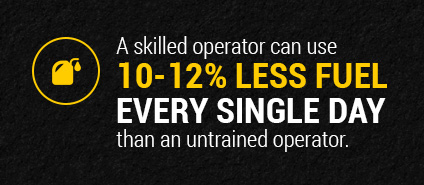 A skilled operator can use 10-12% less fuel every single day than an untrained operator. That adds up fast. One of the keys to this lies in idle time. Some experts estimate idle time alone could account for 40-50% of total equipment running time. That translates to at least one gallon of wasted fuel every hour.
A skilled operator can use 10-12% less fuel every single day than an untrained operator. That adds up fast. One of the keys to this lies in idle time. Some experts estimate idle time alone could account for 40-50% of total equipment running time. That translates to at least one gallon of wasted fuel every hour.
In addition to idle time, untrained operators may also run equipment at full RPMs when it’s not necessary, costing you even more fuel. If you consider fuel alone, the case is strong for investing in the upfront costs of training — those are nothing in comparison to the high cost of fuel that can result from untrained operators.
5. Your technology doesn’t seem to be making an impact.
To see a high return on investment for the technologies you’ve purchased, your operators need to be trained on how and when to use them. If they aren’t, you’ll end up having technology that’s never used or technology that isn’t used correctly. There are a variety of technologies available to prevent over and under-loading, reduce fuel consumption and improve accuracy, among other things.

If you’ve invested in technology but aren’t seeing the results you were hoping for, it may be an indication that the operators aren’t taking advantage of the technology the way they should. Investing in educating your employees in how and when to use the technology may be the key to your technology making more of an impact.
How to Begin a Heavy Equipment Operator Training Program
Let’s assume one or more of these signs is familiar to you in your construction business. What’s the first step in addressing your company’s training needs? How do you put a training process in place that will ensure you’ve educated your operators? Operator training comes in all shapes and sizes. What works for a large construction business may not be the same solution that works best for a smaller company.
Regardless of the size and shape of your business, here are the five main steps to get started:
1. Decide whether you’ll train in-house or hire a professional.
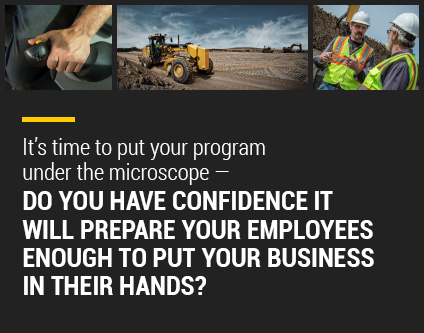 Decide whether or not you have the time and resources necessary to dedicate to in-house equipment operator training. If you haven’t had a formal operator training program in place before, this is a great time to make a list of pros and cons. If you’ve trained operators in-house in the past, it’s time to put your program under the microscope — do you have confidence it will prepare your employees enough to put your business in their hands?
Decide whether or not you have the time and resources necessary to dedicate to in-house equipment operator training. If you haven’t had a formal operator training program in place before, this is a great time to make a list of pros and cons. If you’ve trained operators in-house in the past, it’s time to put your program under the microscope — do you have confidence it will prepare your employees enough to put your business in their hands?
In-house training doesn’t necessarily mean you have to develop the curriculum. There are several options available for purchasing curriculum and having an employee teach the training. If you’d rather not dedicate a staff member to the operator training, consider hiring a professional trainer. While it’s more of a financial investment, it may be worth it not to bother with it in-house. There is no right or wrong answer — it ultimately depends on the company.
2. Select/develop curriculum or a trainer.
Once you’ve made a decision, you’re going to need to do one of three things: create/revise your training curriculum, research and evaluate new curriculum or research and interview professional trainers.
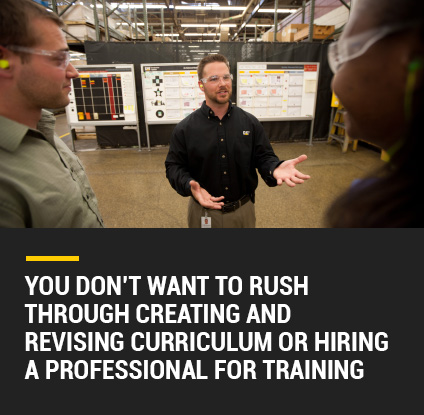 Creating/revising your training curriculum — If you’ve decided to provide in-house training and you plan to use your curriculum, you’re going to have to begin an outline and create a timeline. Even if you already have a training program in place, it’s a good idea to revisit the curriculum and make revisions based on new equipment and/or newer models you’ve purchased.
Creating/revising your training curriculum — If you’ve decided to provide in-house training and you plan to use your curriculum, you’re going to have to begin an outline and create a timeline. Even if you already have a training program in place, it’s a good idea to revisit the curriculum and make revisions based on new equipment and/or newer models you’ve purchased.- Researching and evaluating new curriculum — If you’ve decided to provide in-house operator training but want to purchase curriculum to use, you’ll need to research and evaluate different options. If you aren’t sure where to start, OSHA and your equipment manufacturer are two places to check for recommendations for operator training curriculum.
- Researching and interviewing professional trainers — OSHA and your equipment manufacturer can also help if you’ve decided to outsource and are interested in hiring a professional trainer. In fact, some manufacturers, like Caterpillar®, provide equipment training programs through their local dealers. Ask the tough questions when you get the opportunity to talk to prospective trainers. It’s important to be confident this person is going to prepare your workforce to work safely and efficiently.
Remember, you don’t want to rush through creating and revising curriculum or hiring a professional for training. If you do, there’s a chance operators won’t be appropriately trained, and the time and money you invested could be worthless. Make sure regardless of what you choose, you are thorough.
3. Determine if you’ll train one-on-one or in a group.
Chances are you’ve had a vision in your head of one-on-one training or group training from the very beginning. Even if you’ve already made up your mind, it doesn’t hurt to review the main pros and cons to ensure you’ve considered all of your options.
One-on-one training gives you the flexibility to ensure that new employees are trained immediately upon hire. It also doesn’t have as much of an impact on productivity when you have one employee off the job site. However, group training requires less of a time commitment, as you can maximize the number of people you train at once.
There are pros and cons to both options — perhaps you’ll decide on a mix. Regardless of what you choose, make sure you come up with a solution that works best for your employees. While productivity may take a short-term hit for training, you can expect it to increase once training is complete.
4. Create a plan for training both new and seasoned employees.
Yes, all equipment operators need to have the same level of operator training, but you’re going to need a plan for both new and seasoned employees. New employees will likely be trained as they are hired, but experienced employees will need a refresher, especially as you purchase new equipment and implement new equipment technologies. How often will you hold refresher training opportunities for them? Assuming they will be mandatory, how will you enforce them?

You also need to consider your company’s policy on cross-training. Are you going to cross-train any of your employees? For example, will aerial lift operator training and general heavy equipment training both be provided? Again, it’s important to weigh the pros and cons. While cross-training gives you flexibility on the job, it needs to be balanced with the depth of knowledge in one particular area. These are just a few things to consider as you develop training plans for both new and seasoned employees.
5. Schedule your training program.
While it may seem easy to choose a series of dates and times and get them on the calendar, this is one of the toughest parts of providing operator training. Why? You have to decide whether to take up time during the workday or schedule in the evenings or on weekends. You have projects with deadlines, and those deadlines require a certain number of workers to be met.
Is there flexibility in your schedule? If not, how will you schedule training? Is there room to do some training during the workday and others in the evening? No matter what you choose, make sure you incorporate on-the-job training in addition to any classroom training. It’s ideal to give employees the opportunity to learn and then practice what they’ve learned on site, with close supervision.
Risks Associated with Not Training Operators
If implementing a training program seems like a lot of work, that’s because it is. If you’re having second thoughts, let us assure you that the risks of not training operators alone are worth all of the time and money you invest in operator training.
If you have not provided operator training and an accident occurs and causes an injury or death, your company is likely to face a lawsuit. While the details of every accident and lawsuit differ, one thing remains the same: Your company assets are at risk if you’re found to be at fault. One of the first things you’ll be asked to document as a part of that lawsuit is the training that was provided for the operator. You’ll have to provide curriculum and show how the training was enforced. If you haven’t taken steps to ensure proper training, all your company assets are at risk of being lost. When you put it into perspective, the sacrifices involved in getting all your operators trained seem small.

Research indicates that almost 80% of unscheduled production downtime is preventable — half of it is due to operator error. When operators aren’t trained, they make errors that result in accidents, equipment damage and downtime — all of which cost you money. If you’re fortunate enough to avoid a lawsuit, you still cost your company money in various areas as a result of not training your operators.
Benefits of Operator Training
In addition to minimizing your legal and financial risks, there are several benefits to training your equipment operators. While the coordination of operator training may seem like lost time and money, you can be confident in the fact that your time and money will be returned through the following perks post training.
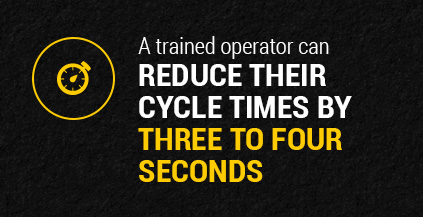 Increase productivity – A trained operator can reduce their cycle times by three to four seconds. While a few seconds may not seem like much, over time, it adds up, increasing your profit margin. If operators know how to use their equipment, they know how to get the most out of it. The result is moving, digging, loading and hauling faster, while improving accuracy. Suddenly, missing production goals and deadlines will become a thing of the past — and your company will be working more efficiently.
Increase productivity – A trained operator can reduce their cycle times by three to four seconds. While a few seconds may not seem like much, over time, it adds up, increasing your profit margin. If operators know how to use their equipment, they know how to get the most out of it. The result is moving, digging, loading and hauling faster, while improving accuracy. Suddenly, missing production goals and deadlines will become a thing of the past — and your company will be working more efficiently.- Minimize equipment downtime – Trained operators are familiar with the equipment. They perform daily visual inspections and are more careful in operating the equipment. As a result of more cautious operation, less maintenance is required, and when maintenance is required, it’s caught early, ensuring optimum care and maximizing the life of the equipment.
- Reduce risk of accidents on site – If your operators are educated on how to operate equipment, they’re going to run the equipment safely, decreasing the risk of accidents and injuries on site. You’ll have less employee downtime as a result of injuries, less tied up in insurance premiums and a healthier workforce. Operators will also be empowered to make safe decisions about equipment operation when they find themselves in different situations in the field.
- Minimize job site errors – Humans operate equipment, and so there’s always going to be room for human error. Eliminating it isn’t possible, but you can do the next best thing — minimize it. Even small errors made on site can lead to expensive rework. No one wants to spend an additional expense to fix what training could have prevented.
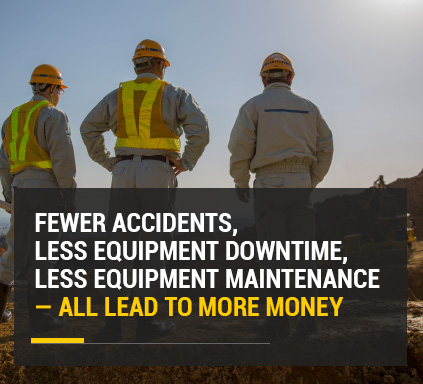 Decrease fuel costs – Remember, a skilled operator can use 10-12% less fuel in a day than an unskilled one. That’s because a trained operator knows when it’s appropriate to run equipment on economy mode, full RPMs and idle. With every member of your team trained, the savings add up.
Decrease fuel costs – Remember, a skilled operator can use 10-12% less fuel in a day than an unskilled one. That’s because a trained operator knows when it’s appropriate to run equipment on economy mode, full RPMs and idle. With every member of your team trained, the savings add up.- Maximize ROI on equipment technology – If you’ve invested in technology that is designed to improve performance — reduce fuel consumption, improve accuracy, boost efficiency, etc., then make sure you’re getting a return on your investment. When operators are trained, they understand not only how the equipment works but also how the technology can maximize performance. Therefore, you can be confident you’re getting your money’s worth, both in the technology and the training you provide.
- Save money – Fewer accidents, less equipment downtime, less equipment maintenance — all lead to more money. Over time, the costs associated with trained operators are significant.
Caterpillar and MacAllister Rentals Can Help with Training Needs
Caterpillar understands that the most critical part of any Cat® equipment is the operator. Their Caterpillar Equipment Training Solutions provides operator training through classroom and in-the-iron activities with the ultimate goal of operating your Cat equipment safely and efficiently. Training is provided through local dealers.
If you’re searching for operator training in Indiana or Michigan, MacAllister Rentals provides ANSI Aerial Lift and OSHA Telehandler training conducted by qualified instructors. To schedule a training for employees, visit our operator training page. Looking for training in other areas? Contact MacAllister Rentals, and we will use our network to get you connected with an operator training provider.
